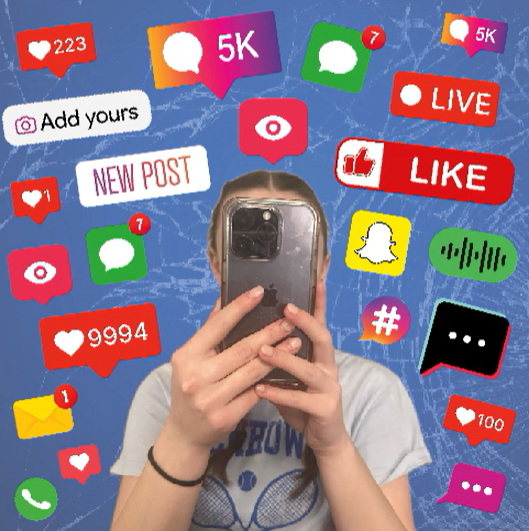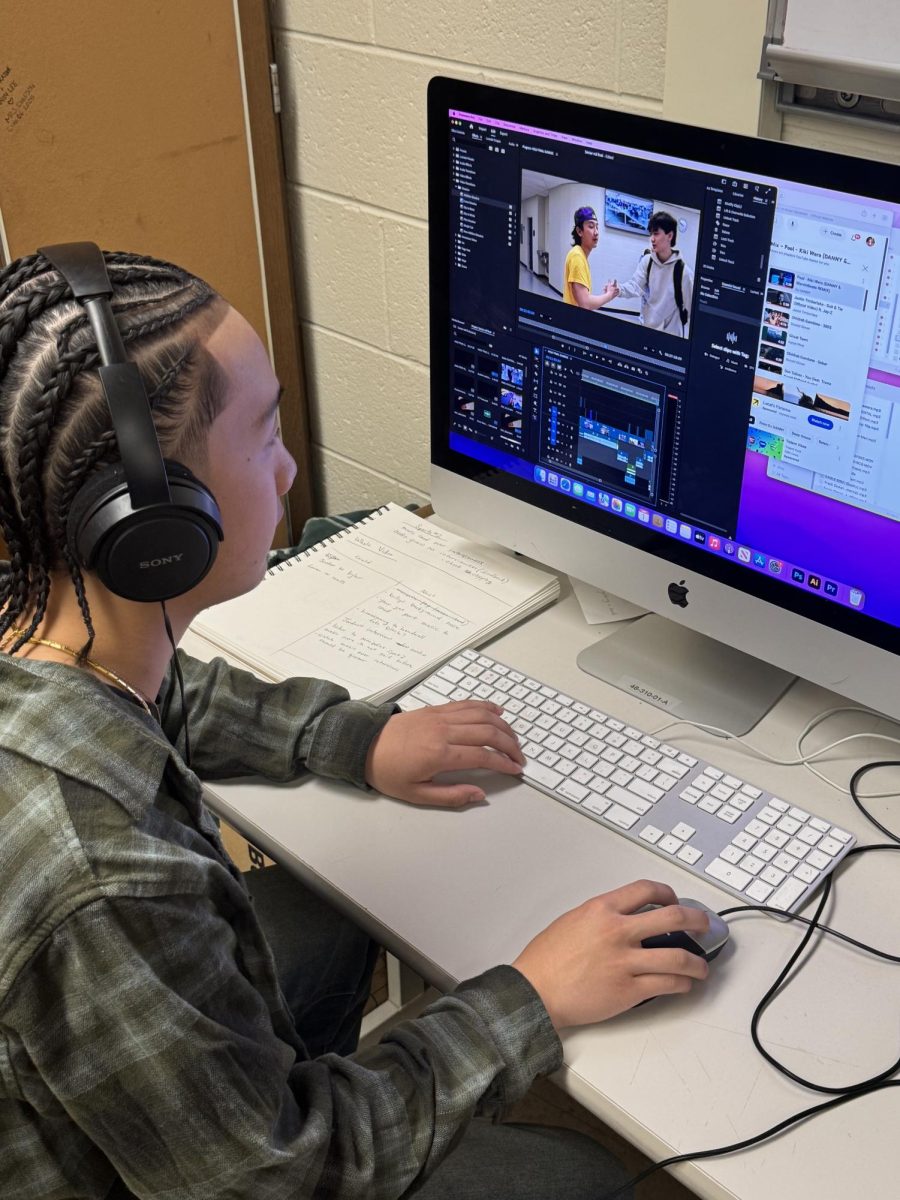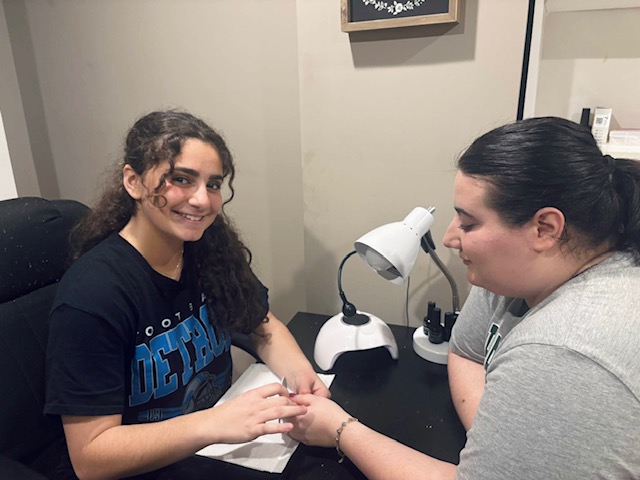Today’s rabbit hole leading teens into a wonderland of discovery is the internet, however, along with the euphoric landscape of the web comes darker risks.
Mental Health
Mental health is a heavily talked about topic when it comes to social media, other online content and its positive and negative imprints on teens.
“There’s a variety of ways that social media impacts young people, especially at the formative stages of developing their own identity but also learning about themselves and the world. And I think it is hard to talk about the negative impacts without addressing the positive impact,” Michigan State University professor of advertising and public relations Saleem Alhabash said.
Social media brought on a new entity for self expression over the years. Millions flock to the internet when they have something to say, prove or show. This leaves an opening for everyone to share their opinions on other people, whether they be positive or negative.
“I see there’s a lot of positives in terms of just exposure to multiple opinions and ideas and approaches but also identifying with some of how young people are seeing others going through similar lived experiences. So that has a really deeply profound impact on young people. But on the negative side, I think there’s tons of research that indicates potential negative impacts, sort of depression and anxiety, primarily because of the dynamics of interpersonal communication relationships on these platforms, but also its impact on self image and self worth,” Alhabash said.
Since social media’s uprise, rates of depression, anxiety and suicide have roared. In a study conducted by the Texas Youth Depression and Suicide Research Network, they reported that 40.3 percent of participants reported problematic social media use. These problematic users also showed higher symptoms of depression, anxiety and suicidal thoughts.
Seeing the likes and comments flow through in notifications generates an exhilarating feeling, knowing others loved the post or thought it was funny. On the other hand, the freedom of commenting anything on a person’s mind along with the anonymity of it can lead to users turning nasty behind the screen.
Not everyone can shake off the negativity they see on their social apps. A constant thread of negative attention or stressful events shown on the internet can easily make user’s mindsets plummet. Research shows that teens who spend the most time on social media are reported to possess a higher rate of depression, according to the Child Mind Institute. This is especially prevalent when bringing cyberbullying into the mix.
“People on social media, even when their picture is up, they feel anonymous. They feel that anonymity gives them an excuse to not care a lot about being polite or about phrasing things in a way that does not hurt other people. So, it removes that level of control from our brain and that can manifest itself in people really being aggressive online and not kind to one another,” Alhabash said.
Digital footprints last forever. A negative comment an angry Instagram user left on another user’s post can always resurface online. More importantly, it can always be recovered in the person’s mind on the receiving end.
“The other aspect with social media, and it’s different with offline bullying or physical space bullying, is this notion that things that can be recorded online can be archived for a very long time. So, instances of bullying can stay for a long time and can be searchable. So, the impact can be elongated. You can get so tangled in it that you don’t feel that you can escape it,” Alhabash said.
On social media there is a line that can be crossed. Who does one want to be when they log onto the internet? Everyone has the choice between leaving a positive or negative impact on someone else’s life. It’s up to users to determine who they want to be. The internet is a weak point where anything can be said to anyone, driving up numbers when it comes to critical mental health problems.
“Understand the risks, protecting your data and privacy, if you see something that is a red flag, stop, do not engage,” Alhabash said. “Don’t take the risks in terms of other aspects thinking about, if you see someone being hurt or someone being aggressive toward other people, intervene in by reporting, by reaching out to the victims and giving them support.”
Decision making
Whether it be addictive behaviors, peer pressure or regular day-to-day decisions, the internet maintains a chokehold on some teens and the decisions they make especially when it comes to who or what they’re interacting with.
“There’s a lot of risks and dangers that can stem from a sort of deeper interpersonal communication with others. So there’s a growing risk of young people being groomed online, right so talking to catfish or adults who are acting like young people and being pushed to engage in risky behaviors, such as sharing risky pictures and being sort of manipulated and groomed into engaging in harmful acts because of fear that this information is going to get out to the public or be shared with others,” Alhabash said.
Anything is easily accessible when it comes to the internet. Whether it’s seeing a new hairstyle, fashion trend or more dangerous behaviors like sending risky photos or someone promoting smoking, it can drive impressionable teens to follow those examples based on different factors.
“Social media has a significant influence on how teens make their decisions, such as feeling the need to fit into a certain beauty standard, seeking validation through likes and comments and looking up to certain influencers and mimicking their behaviors and decisions,” senior Dighi Dhar said.
Influencers on the web can coax their followers into buying and trying different things which lands on the lighter end of the spectrum. However, the darker side lurks with sketchy people pushing or peer pressuring another account to engage in risky behavior.
“There’s the reactive part, but there’s also the proactive part and this deals with enhancing social media literacy among young people of understanding and requires us to take a critical look about how these platforms are influencing and affecting young people is also and in order to have these practice strategies, schools and parents have to create an environment of safety that young people can talk about these experiences without fear of getting in trouble,” Alhabash said.
The reactive approach to constantly being on social media, according to Alhabash, teens can become disconnected from their real life counterparts including friends and family, placing social media as their first priority. Another side to this is not keeping up with grades and procrastinating schoolwork to stay online longer.
“The big issue, primarily because at these formative years as young people, you are still sort of building and developing what is called your executive function, which is that part of the brain that regulates your emotions,” Alhabash said. “But also it regulates your motivation to do things, so it gives you an ability to control yourself and disengage from social media, and this is always on, always accessible, always wanting to post and comment and be in the know, and the fear of missing out they might be interfering with this process of developing strong executive function.”
Body image
Standards are ingrained into society: how to dress, think, act, look, consume and eat is singed into younger minds as everyone tries to fit into a mold that’s forced on them.
“Social media and how people present and form, try to manage their impressions, creates this level of high expectations of who we should be and how we should look like, and what kind you know how our bodies should look and what is considered pretty and attractive, and also certain aspects of internalizing that and making that comparison as an important pillar in seeing how we set our self worth,” Alhabash said.
Negative body image through social media has increased over the years. In a study conducted by the American Psychological association, they found negative body esteem went down when teens reduced social media use by 50 percent.
“I think teens, especially girls, are extremely influenced by what we see on social media. There’s always a perfect body type or certain weight. Honestly, it’s just exhausting keeping up with all of it because we’re never really perfect or right according to society,” senior Madison Emerson said.
While there’s a large emphasis on girl’s bodies on the internet, boys also go through the same low self-esteem that comes with body image.
The internet portrays the standard to live up to, showing specific looks over and over through the algorithm. Constantly seeing perfect visions of people who seemingly possess no insecurities and are praised by the masses can influence the way teens judge themselves.
“We judge people on whether they’re authentic or not, and genuine or not, and the matter of fact is, I’m not sure that we know anymore what is authentic,” Alhabash said. “Because what is authentic when I, as a person, would have to put tons of makeup before recording a video and add a bunch of filters to make me look prettier. So is that truly authentic?”
Buying habits
The drive to purchase things heightened with consumption of social media promoting thousands of new and different products.
“Social media envy, a painful emotion, arises when social media users engage in unfavorable upward social comparison due to their desire to possess but lack the possessions and life experiences shared in the social network by others (e.g., friends, social media influencers),” according to BMC psychology.
Social media users allow themselves to be led in their opinions about different items, feeling the need to have something they don’t already own. Annual advertising revenue across 6 different media platforms in 2022 from users under 18 in the United States nearly hit $11 billion according to a study by PLOS ONE, a peer reviewed mega journal.
“Significant factors impacting purchasing decisions include product recommendations from friends and family (41.1%) and online reviews (38.9%), with 53.3% of respondents acknowledging that social media has affected their spending habits,” according to the International Organization of Scientific Research.
Purchases are made due to a number of surrounding influences on social media including seeing what friends are liking and what social media influencers promote. Marketing schemes also line account’s algorithms, tempting people to hit the purchase button. Influencers also use simple phrases like “everyone has this” or “selling out” to enhance temptations creating a fear of missing out (fomo).
All of this stems from decision making, going back to the executive function. Fomo blocks this function and users feel the itch to purchase an item based on others influence and scratch that itch by giving in and pressing the buy button.
“Social media has a big influence on us,” junior Aiden Routledge said. “A lot of the videos make the product look nice, so it influences people to buy it. Sometimes it can make us feel insecure when people have something we don’t, so that’s what drives impulsive online purchases.”







